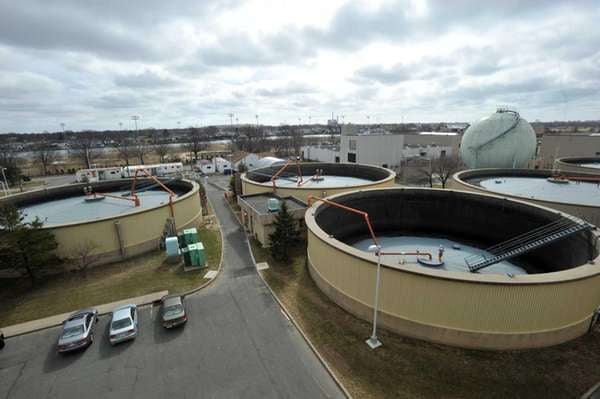
Two leading environmental groups are supporting an Ocean Outfall Pipe for the Bay Park Sewage Treatment Plant that would go straight off of Long Beach. We of course think it is a bad idea to put a new pipe in the ocean. Pollution or even the perception of pollution in Long Beach would be bad for the beach-based economy. But more importantly, we think this is a major waste of fresh, treated water. Our groundwater aquifers are being over-drafted, polluted, and they suffer from saltwater intrusion. Better treatment of this water including de-nitrification would allow us to use the water to replenish aquifers or for some other beneficial re-use.
Opinion: Send our treated sewage out to sea
Published: January 19, 2014 8:50 PM
By ADRIENNE ESPOSITO AND CARL LoBUE

Shown are digestor tanks at the Bay Park Sewage Treatment Plant in East Rockaway. At right is a 60-foot-high gas sphere on March 9, 2011. (Credit: Kevin P. Coughlin)
The effect of superstorm Sandy still lingers across Long Island, and no greater impact to infrastructure can be identified than the damage to the Bay Park sewage treatment plant. Kudos to Sen. Charles Schumer, Gov. Andrew M. Cuomo and Nassau County Executive Edward Mangano for prioritizing repairs and upgrades.
The facility serves more than 500,000 people. More than 50 million gallons of treated sewage flow daily from the plant into the western bays. When Sandy sent a 9-foot wave into the plant, damage was extensive. Nassau County has adopted temporary measures to ensure operation. Studies and planning efforts provide clear guidance on how to rebuild and re-engineer this plant. However, if the goal for our Sandy recovery is to rebuild better and smarter, then the plant’s reconstruction must include an ocean outfall pipe, which would transport treated sewage to the Atlantic.
The Western Bays Coalition, a group of environmentalists, civic groups and elected officials, has worked for more than a decade to reduce the adverse impact of wastewater discharges to our South Shore bays. Through those efforts, $1.64 million has been allocated to study the effects of the discharge.
CARTOONS: Jimmy Margulies' cartoons | Cartoon roundup
MORE: Viewsday blog | Newsday columnists | More opinion
CONNECT: Subscribe to our e-mail list | Twitter | Facebook
The science is conclusive: Our western bays are rapidly degrading. Studies by Stony Brook University identify nitrogen from sewage as causing harmful algae blooms, hypoxia (low oxygen), excessive ulva seaweed growth, and deterioration of salt marsh islands. The ulva grows so thick that when it decomposes, it releases noxious hydrogen sulfide gas that threatens the health of nearby communities. Low oxygen levels kill fish, and harmful algae blooms force the closure of shellfish beds.
Every windy day, the densely populated low-elevation communities along Nassau’s South Shore are protected from wave damage by salt marshes. This protection comes from the strength of marsh root systems, but those are weakened by excessive nitrogen from treated sewage. Degradation of the estuary also hurts the ocean ecosystem by negatively affecting nurseries and foraging areas for economically and ecologically important fish and wildlife.
The damage can be prevented. Fishing, boating, beach use, housing values, clamming, and water-dependent businesses such as restaurants, depend on clean bays. They, in turn, depend on making the right decisions about upgrading the plant.The coalition considered all viable options to manage the plant’s discharge. However, even with the best available treatment technologies, this high volume of wastewater still requires an ocean outfall pipe. Disruptions at the plant before Sandy, and then exacerbated by Sandy, provide another rationale for outfall relocation to the ocean. High-volume sewage outfalls close to densely populated fishing and boating communities create a human health threat. While disruptions ideally can be averted, we would be naive to believe they won’t recur. If Sandy had occurred in the summer — when people would be swimming and boating — the discharge would have triggered human health crises at the exact time residents and emergency crews were dealing with other storm-related crises. Ocean discharge is the best option.
Millions of dollars are being spent to help Long Beach, Island Park, Freeport, Oceanside and other communities. Yet, without proper re-engineering of the plant, we will not realize a full economic recovery. If the communities are to remain viable, the integrity and health of our marine resources must be included in all storm recovery plans. The restoration of our waterways is essential to a sustainable island economy and healthy life. Rebuilding without transforming is not recovery. An ocean outfall pipe is a necessity, not a luxury.
